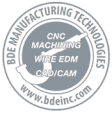Posted On: September 27, 2018
The manufacturing industry requires different types of machines, instruments, and equipment to carry out various processes, for manufacturing products. Among these many equipment and instruments used in the said industry, is one machine, which has a great importance – milling machine. What is this machine? What are the various parts of a milling machine? Are you curious to know? If yes, then read the following post, which answers these questions for you.
What is a Milling Machine?
A milling machine is an equipment most commonly used for shaping solid materials, such as metal, or wood. It features a cutting tool, which revolves, and helps machine the workpiece. It can be used to machine workpieces of almost any size or shape.
What are the Different Parts of a Milling Machine?
A milling machine consists of a variety of parts that work together to deliver quality machined parts. Here are different parts of a milling machine:
• Base: The base consists of the cutting fluid, and also acts as a strong support to the machine.
• Column: A column is mounted on the base, and is another foundation part of the machine. Generally, the motor for table and spindle, and driving gears are contained in the column.
• Knee: It is fitted over the column, and is the first moving part in the milling machine assembly. The knee is moved over slideways of the column to adjust the distance between the workpiece and the tool.
• Saddle: The saddle acts as an intermediate part between the knee and the table. It helps provide horizontal movement to the workpiece.
• Spindle: This part uses a motor to drive the tool. In a vertical milling machine, the spindle is responsible to hold the tool at the correct position, whereas in the horizontal milling machine, it is used to hold arbor.
• Overhanging Arm: The overhanging arm, or overarm is fixed at the top of the column, and provides support to the arbor.
• Table: The saddle provides guideways for the table to rest on them. The table supports the workpiece and features T-slots. The table is capable of giving the workpiece motions in three directions – longitudinal, cross, and vertical.
• Arbor: Arbor is the mechanical part, which helps move the cutters in the right direction.
• Arbor Supports: It forms the bridge between the arbor and overhanging arm. As the name suggests, this part supports the arbor.
• Milling Head: The milling head is a combination of different small parts, like driving motor, spindle, and other controlling mechanisms of the milling machine.
• Elevating Screws: The elevating screws are used to allow the upward and downward movement of the table and knee.
It is important that each part of a milling machine works properly, in order to facilitate effective milling. Therefore, it is advisable to avail milling services from experts, such as BDE, Inc., who have well-maintained milling machines, and a vast experience of offering machining services and capabilities, such as reaming, boring, knurling, etc.
Related Blog Post:
• Basic Skills Required to Conduct CNC Milling Operations – Part 1
• Basic Skills Required to Conduct CNC Milling Operations – Part 2
 info@bdeinc.com
info@bdeinc.com 866.262.6233
866.262.6233





